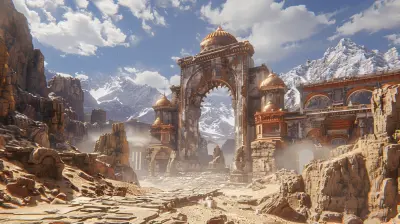VR Game Development: Challenges and Opportunities for New Developers
6 August 2025
Welcome to the wild, slightly dizzying, and incredibly exciting world of VR game development. If you’re a new developer, just dipping your toes into virtual reality, you’re in for a ride. There’s a lot to love—and a lot to learn. But don’t worry—I've got your back!
In this article, we’ll dive deep into the nitty-gritty of VR game development. We’ll talk about what makes it so unique, the head-scratching challenges you might face, the golden opportunities waiting for the bold, and how to get started without losing your mind (or your lunch).
Let’s put on those headsets and step into the future of gaming, shall we?
What Makes VR Game Development So Different?
Creating a VR game is like building a rollercoaster—while riding it. It’s a totally different beast compared to traditional game development. The rules change, the tools are different, and even your players’ expectations shift.1. Full Immersion = Full Responsibility
In VR, players are no longer staring at a screen—they're inside your game world. This means every little detail matters. The lighting, the sound, the way objects move, even how the menus pop up—all of it needs to feel natural and believable.If something feels off? Trust me, your players will feel it… and maybe even feel a little sick.
2. Physicality Changes Everything
Unlike flat-screen gaming, in VR, people use their whole body. Hand tracking, eye tracking, head movements, and even walking around (if you’re using room-scale VR) all play a part.So movement, interaction, and combat in VR can't just be ported from traditional controls. They need to be reimagined from the ground up. Players expect intuitive and fluid motions. If it feels clunky, it breaks immersion—fast.
3. Performance Is King
VR needs games to run buttery-smooth. We're talking about 90 frames per second or more. Why? Because lower frame rates can cause motion sickness—and that’s the fastest way to lose your audience.So, optimization isn’t just a best practice in VR. It’s survival.
The Biggest Challenges for New VR Developers
Let’s get real for a second. Yes, VR is exciting. But it’s also tough—especially when you're just starting out. Here are some of the most common roadblocks you might hit.1. Learning Curve from Hell
Most devs come from 2D or standard 3D game backgrounds. Moving to VR? It’s a whole new skillset. Suddenly you need to understand spatial audio, 6DoF (six degrees of freedom), motion controls, and different SDKs for different headsets.And let’s not even talk about testing your game—because if you thought debugging on a monitor was bad, try doing it while wearing a VR headset.
2. Hardware Fragmentation
There’s no “one VR headset to rule them all.” Oculus (Meta Quest), HTC Vive, Valve Index, PSVR… each comes with its quirks and requirements. Some support room-scale, some don’t. Some have better controllers, some rely on hand tracking.As a new developer, targeting all platforms can be a nightmare. You’ve got to make some tough calls or be ready to sink in serious dev time for multi-platform support.
3. User Comfort Is Non-Negotiable
Motion sickness is a huge issue in VR. Design your game wrong, and people will rip off their headset in a dizzy rage. It’s not just about graphics or gameplay—comfort is king.Smooth locomotion, snap turning, low latency, reducing simulator sickness—these things aren’t nice-to-haves. They’re must-haves.
4. Limited Resources and Documentation
Sure, there are plenty of Unity and Unreal tutorials out there. But VR-specific content? Not nearly as much. Especially if you're trying to do something beyond the basics.You’ll likely spend hours scouring forums, reverse-engineering demo scenes, and testing endless combinations to make something… work-ish.
Opportunities for Brave New VR Developers
Okay, let’s flip the script. Yes, VR is hard. But that also means the bar hasn’t been set sky-high—yet. This space is still fairly new, which opens up game-changing (pun intended) possibilities.1. A Less Crowded Market
Let’s face it. Launching a mobile or PC game in 2024? You're up against millions of competitors. Launching a VR game? The competition thins a lot.If you’ve got a fresh idea, you can stand out much easier in the VR space. It’s like the early days of mobile—those who act now could become tomorrow’s VR Rockstars.
2. Players Are Hungry for Content
VR users are craving quality games. There simply isn’t enough great VR content out there. Many players are repeating the same few titles (here’s looking at you, Beat Saber).That’s a massive opportunity. If you can create something fun, polished, and comfortable—it’s going to get noticed.
3. Innovative Gameplay Possibilities
VR opens doors to mechanics that just wouldn’t work on a flat screen. Think dodging bullets with your real body, or whispering into a mic to distract an enemy.Want to create an escape room where players physically walk around and interact with clues? VR makes that magic happen.
As a developer, you can let your creativity run wild. This isn’t about copying what’s worked before. It’s about inventing what’s next.
4. Backed by Big Players
The future of VR is being pushed hard by giants like Meta, Sony, Apple, and Valve. That means funding, accelerator programs, and other support for indie and new devs is actually available.Examples? Oculus’ Start and Launch Pad programs offer mentorship, funding, and promotion for new developers. So don’t be afraid to knock on those doors.
Must-Have Tools for VR Game Development
Alright, let’s talk gear and software. When you're just starting out, it’s easy to get overwhelmed. Here’s a quick cheat sheet of what you’ll need (and why).Game Engines
- Unity – Hands-down the most popular for VR. Tons of plugins, tutorials, and platform support.- Unreal Engine – Visually stunning results, great for AAA-quality visuals, but steeper learning curve.
Both engines now support VR out of the box, but Unity typically gives indie devs a faster ramp-up.
SDKs and APIs
- OpenXR – The new standard for cross-platform VR development. Use this as your foundation.- Oculus SDK – Required for Quest and Rift features.
- SteamVR SDK – Needed for HTC Vive, Valve Index, and any Steam-compatible headset.
- PSVR Dev Kit – Closed ecosystem, but necessary if you want to develop for PlayStation’s hardware.
Hardware
Start small—you don’t need every headset on the market. A standalone Meta Quest 2 or Quest 3 is a solid entry point. It’s affordable, versatile, and has a massive user base.Tips to Survive (and Thrive) as a Beginner
Here’s some hard-earned advice most devs wish they knew earlier:Start Simple
Don’t try to build the next Half-Life: Alyx on your first try. Create a small experience. Maybe a 5-minute puzzle game or a simple archery challenge. Focus on nailing comfort, interaction, and fun.Play Other VR Games Obsessively
Want to understand what works in VR? Play everything. Look at movement systems, UI, how tutorials are handled, and how players interact with the world. Learn from the greats—and even the not-so-greats.Talk to Real Users
Get feedback early and often. VR behaves differently for different people. What makes one person nauseous might be fine for another. Watching people try your game can teach you more than hours of theory.Stay Connected with the Community
Join VR dev forums, Discord servers, subreddits like r/VRdev. Ask questions. Share your builds. You’ll find devs willing to help—and you’ll avoid reinventing the wheel.Keep Optimizing
I’ll say it again—performance matters like crazy in VR. Use occlusion culling, baked lighting, LODs, and all the dirty tricks in the book. A beautiful game that makes people puke is not a win.Looking Ahead: Is VR Really the Future?
Good question. Is VR just a niche? A passing trend? Maybe. But here’s the thing—it’s got staying power. And it keeps evolving.With Apple’s Vision Pro pushing the envelope, mixed reality becoming more mainstream, and improvements in wireless and standalone headsets, we're inching closer to that sci-fi dream where digital worlds and real ones blend seamlessly.
And you, brave developer, are in a prime spot to shape that future.
Whether you’re building the next social VR hangout, intense action game, or a chill mindfulness experience, the possibilities are endless—and still wide open.
Final Thoughts
VR game development is not for the faint of heart. It’s messy, experimental, and constantly changing. But that’s also what makes it so damn exciting.Yes, the learning curve is steep. But if you're passionate, curious, and ready to push boundaries, the rewards are absolutely worth it.
So go ahead, take a deep breath, strap on that headset, and start building your virtual dream.
The future is yours—just reach out and grab it (literally).
all images in this post were generated using AI tools
Category:
Virtual RealityAuthor:

Leif Coleman
Discussion
rate this article
1 comments
Savannah McMahan
Great insights on the challenges and opportunities in VR game development! Your article effectively highlights essential considerations for new developers looking to navigate this exciting and evolving landscape.
August 16, 2025 at 3:23 AM

Leif Coleman
Thank you for your kind words! I'm glad you found the insights helpful for new developers in the VR space.


